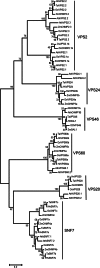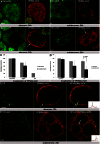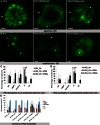Cell layer-specific distribution of transiently expressed barley ESCRT-III component HvVPS60 in developing barley endosperm
- PMID: 25796522
- PMCID: PMC4712231
- DOI: 10.1007/s00709-015-0798-1
Cell layer-specific distribution of transiently expressed barley ESCRT-III component HvVPS60 in developing barley endosperm
Abstract
The significance of the endosomal sorting complexes required for transport (ESCRT)-III in cereal endosperm has been shown by the identification of the recessive mutant supernumerary aleurone layer1 (SAL1) in maize. ESCRT-III is indispensable in the final membrane fission step during biogenesis of multivesicular bodies (MVBs), responsible for protein sorting to vacuoles and to the cell surface. Here, we annotated barley ESCRT-III members in the (model) crop Hordeum vulgare and show that all identified members are expressed in developing barley endosperm. We used fluorescently tagged core ESCRT-III members HvSNF7a/CHMP4 and HvVPS24/CHMP3 and the associated ESCRT-III component HvVPS60a/CHMP5 for transient localization studies in barley endosperm. In vivo confocal microscopic analyses show that the localization of recombinantly expressed HvSNF7a, HvVPS24 and HvVPS60a differs within barley endosperm. Whereas HvSNF7a induces large agglomerations, HvVPS24 shows mainly cytosolic localization in aleurone and subaleurone. In contrast, HvVPS60a localizes strongly at the plasma membrane in aleurone. In subaleurone, HvVPS60a was found to a lesser extent at the plasma membrane and at vacuolar membranes. These results indicate that the steady-state association of ESCRT-III may be influenced by cell layer-specific protein deposition or trafficking and remodelling of the endomembrane system in endosperm. We show that sorting of an artificially mono-ubiquitinated Arabidopsis plasma membrane protein is inhibited by HvVPS60a in aleurone. The involvement of HvVPS60a in different cell layer-specific trafficking pathways, reflected by localization of HvVPS60a at the plasma membrane in aleurone and at the PSV membrane in subaleurone, is discussed.
Keywords: Barley; Cell layer-specific; ESCRT-III; Endosperm; Seed; VPS60.
Figures






Similar articles
-
Protein sorting into protein bodies during barley endosperm development is putatively regulated by cytoskeleton members, MVBs and the HvSNF7s.Sci Rep. 2020 Feb 5;10(1):1864. doi: 10.1038/s41598-020-58740-x. Sci Rep. 2020. PMID: 32024857 Free PMC article.
-
ESCRTing in cereals: still a long way to go.Sci China Life Sci. 2019 Sep;62(9):1144-1152. doi: 10.1007/s11427-019-9572-9. Epub 2019 Jul 19. Sci China Life Sci. 2019. PMID: 31327097 Review.
-
Fusion, rupture, and degeneration: the fate of in vivo-labelled PSVs in developing barley endosperm.J Exp Bot. 2014 Jul;65(12):3249-61. doi: 10.1093/jxb/eru175. Epub 2014 May 6. J Exp Bot. 2014. PMID: 24803499 Free PMC article.
-
Delivery of prolamins to the protein storage vacuole in maize aleurone cells.Plant Cell. 2011 Feb;23(2):769-84. doi: 10.1105/tpc.110.082156. Epub 2011 Feb 22. Plant Cell. 2011. PMID: 21343414 Free PMC article.
-
Microautophagy in cereal grains: protein storage or degradation?Trends Plant Sci. 2025 Jul;30(7):736-744. doi: 10.1016/j.tplants.2024.12.012. Epub 2025 Jan 21. Trends Plant Sci. 2025. PMID: 39843340 Review.
Cited by
-
Protein sorting into protein bodies during barley endosperm development is putatively regulated by cytoskeleton members, MVBs and the HvSNF7s.Sci Rep. 2020 Feb 5;10(1):1864. doi: 10.1038/s41598-020-58740-x. Sci Rep. 2020. PMID: 32024857 Free PMC article.
-
Using RT-qPCR, Proteomics, and Microscopy to Unravel the Spatio-Temporal Expression and Subcellular Localization of Hordoindolines Across Development in Barley Endosperm.Front Plant Sci. 2018 Jun 13;9:775. doi: 10.3389/fpls.2018.00775. eCollection 2018. Front Plant Sci. 2018. PMID: 29951075 Free PMC article.
-
The biology of exosomes and exosomal non-coding RNAs in cardiovascular diseases.Front Pharmacol. 2025 May 26;16:1529375. doi: 10.3389/fphar.2025.1529375. eCollection 2025. Front Pharmacol. 2025. PMID: 40492132 Free PMC article. Review.
-
Microscopic and Proteomic Analysis of Dissected Developing Barley Endosperm Layers Reveals the Starchy Endosperm as Prominent Storage Tissue for ER-Derived Hordeins Alongside the Accumulation of Barley Protein Disulfide Isomerase (HvPDIL1-1).Front Plant Sci. 2018 Sep 10;9:1248. doi: 10.3389/fpls.2018.01248. eCollection 2018. Front Plant Sci. 2018. PMID: 30250475 Free PMC article.
-
Immunolocalization of hordein synthesis and transport in developing barley endosperm.Plant Direct. 2024 Sep 5;8(9):e591. doi: 10.1002/pld3.591. eCollection 2024 Sep. Plant Direct. 2024. PMID: 39247583 Free PMC article.
References
Publication types
MeSH terms
Substances
Grants and funding
LinkOut - more resources
Full Text Sources
Other Literature Sources

